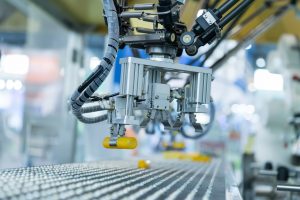
Factory Automation – Taking the Next Steps
Factory automation is a big topic in the manufacturing sector right now. There are many drivers that are increasing this move towards automated processes and systems in manufacturing businesses, but it’s not always easy to see the next steps you should take.
Keith Moran is the Managing Director of SL Controls. It specialises in developing bespoke software solutions for manufacturers in the pharmaceutical and medical device industries to ensure continued regulatory compliance, improve OEE, and make production lines more productive and efficient. Find out more about SL Controls today.
A good place to start is understanding why Factory Automation and Industry 4.0 technologies are important to your business right now. Examples include:
• You are introducing a new product so want to use the opportunity to automate as many of the processes as possible
• Changing regulatory requirements are an increasing burden on your business. You know that Factory Automation technologies can lessen that burden.
• You want to remain competitive in a fast-changing industry where staying at the cutting edge of technology is essential
• Customer expectations are changing, and you want to be able to deliver on those expectations
• You want to make your manufacturing facility more flexible and adaptable to enable you to scale your manufacturing capabilities, introduce small batch manufacturing, take advantage of the opportunities that mass customisation promises, etc.
• You want to drive efficiency savings across your business, not just in manufacturing. This involves digitalising business processes on the factory floor and in other units of the business, improving how you use data, deepening levels of integration, and more.
The above is only a small list of the motivating factors for taking the next steps on your Factory Automation journey to evolve your production line into a Smart Factory.
Where do you go from there, and how do you ensure the process goes smoothly? From implementing integration, controls, automation, and validation solutions in pharmaceutical and medical device manufacturing companies, here are tips from our experience at SL Controls.
Don’t Go Too Far Too Soon
You need to carefully plan the implementation of Factory Automation technologies and processes. Carefully planning and taking it stage-by-stage is easier to budget for financially, it’s less disruptive to your business, it makes it simpler to measure return on investment, and it makes it possible to focus properly on areas of your business and manufacturing processes that would benefit most from the changes.
Assess Your Current Manufacturing and Business Systems and Processes
Before you start implementing any technical solutions, you first need to have a full understanding of your current systems and processes both on your production lines and in other units of your business.
This includes auditing all your equipment, the platforms you use, your IT infrastructure, your Information Systems, your communication capabilities, and more.
Develop a Strategy and Road Map
An above point recommends you implement Factory Automation solutions stage-by-stage, but it also helps to have an overall strategy in place as well as a road map of where you want to get to and the steps along the way.
Develop a Business Case
You will also need to put together a business case that identifies risks and analyses the impact of new solutions and technologies on all aspects of your business. The business case should also make estimates on the return on investment you will achieve.
Taking Your Next Step
At SL Controls, we can help with all the above stages as well as designing, developing, testing, validating, and implementing the solutions that will make each stage a reality.
Factory Automation is the future of the manufacturing sector, particularly in high-precision and highly regulated industries like medical device and pharmaceuticals manufacturing. Enhancing your operations should be a priority.
